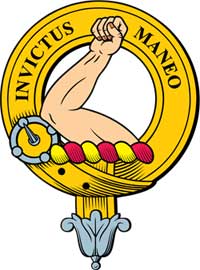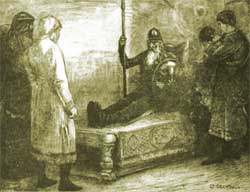In this series of articles Rodger Moffet at ScotClans looks at some of the symbolism used in clan heraldry and explores their meaning and origin. In this episode we look at the powerful border clan, Armstrong.

This blog should probably have the working subtitle ‘just when you thought you knew the answer’. I have to confess that for decades I’ve happily regurgitated the popular story (or one of the popular stories) regarding the origin of the name. However, we live in an age where many popular views of history are being pulled apart and this is no exception.
So lets start with the popular legends. Well first up is the well known and often recited ‘Fairbairn’ story. Fairbairn was the armour bearer to the King of Scotland. It was said that in a battle the King was unseated from his horse. Fairbairn rode up to him and with one arm pulled the King onto the back of his own horse, saving him from certain death. For this deed he was rewarded with lands in Liddesdale and the name ‘Armstrong’ to mark the deed. All pretty straight forward right? Well anyone who has ever attempted to lift a suit of armour (which the King at this time would have been wearing) will tell you that, empty, this is a near impossible task with one arm, never mind a suit of armour with a King still inside it. Now it might be possible that some daring deed was perpetrated and embellished over the years but that is impossible to prove.
Having put the Regent-hoisting Fairbairn to one side we come to Siward, a Viking son of a Danish King. Siward was known as Siward Beorn or Siward Digry, Digry has been purported to mean ‘Strong Arm’ but in fact it translates from Old Norse as Stout so there’s a problem right away. Beorn on the other hand comes from the Old Norse Bjorn. As Beorn in Old English in means Warrior but in Old Norse Bjorn means Bear. The Bear in Norse legends is reputed to relate to the ‘Fairy Bear’ or ‘Fey Bear’ and there we are back to Fairbairn again (also a ‘Fair Bear’ would be a white bear ‘Polar Bear’? you can see how that came about).
So lets stick with Siward for a while.
Siward was one of many Norsemen who travelled over the North Sea during the reign of King Cnut a Scandinavian ruler who had conquered England around 1010. The legend of Siward veers away from any possible historical evidence when it tells us that Siward first travelled to Orkney where he killed a dragon, then sailed to Northumberland to kill another when he was met by an old man who he thought was Odin in disguise. The old man gave him a raven banner and told him to told him to travel to London to seek his fortune. Undercover Norse gods distributing heraldry aside it does finally place our hero at the court of the King.
Siward clearly impressed the king and he was made Earl and given lands in Northumbria. He was also made Earl of Huntingdon after separating the current Earl’s head from his shoulders. Cnut was drawn to Siwards violent tendencies, someone better as an ally than an enemy. In 1035 Cnut died and a power struggle ensued. Siward maintained a sensible neutrality while there was a game of musical thrones and finally Edward the Confessor landed the top job.
He led a few raids north into Scotland and his sister married King Duncan of the Scots. Duncan will be familiar with fans of Shakeseare and when he was killed by MacBeth. Siward supported Malcolm’s claim to the throne. In 1054 Siward’s son invaded Scotland and took on MacBeth at a battle site somewhere around the Firth of Forth known variously as the “Battle of the Seven Sleepers” or the “Battle of Dunsinane”. Siward’s son was killed in this battle, some say by MacBeth himself who was also slain in turn by Malcolm to become King of Scots.
When Siward finally died in 1055 he left a considerable area of land to his descendants who had the unfortunate job of dealing with the Normans who were to hit the shores of Britain a few years later.

So this powerful Viking warrior with his strong sword arm is the progenitor of the noble Armstrong Clan?
Well perhaps not….
You see we live in an age where science can put even the best established claim to the test. DNA testing of Armstrongs has shown the largest clusters to be in the R1b-312 Haplogroup, a group which has very strong Scottish connections possibly Pictish, beaker people or late Neolithic in origin. Time will tell how accurate this is and as the science of DNA testing improves the picture will become clearer. The Scientific evidence certainly disproves the viking origin so were left with ’naught but an airm’.
So there we are. No proven genetic link between Armstrong and the people who have been credited for being the inspiration of the surname. However there is one last spanner in the bag to throw into the works and its this: A few years ago Clan Donald undertook a DNA study. They tested a large group of MacDonalds including the chiefs and their families. The results were interesting, the results of The chief’s and their relatives showed Scandinavian (Viking) origins as you would expect but the Clan people tested all over the place with lots of pictish and irish descent. The best guess is that people living on Clan Donald controlled lands just took the surname so not all MacDonalds share the same DNA. While theres no evidence the same practice took place in the border regions that the Armstrongs occupied they were such a major force in this area its hard to disprove.
In the end may never know.

Rodger
As some Armstrongs have yDNA I-M253, the same as some Hamiltons etc., and a high percentage of I_M253 occurs in
Scandinavia, I wonder if these people may descend from Siward?
It seem like Fairbairn, mainly today on the Scottish eastern border, and Carruthers on the Scottish western border, near Armstrong and Johnstone, seem to carry with exception to NPE Non Parental Events, I-M253, though found as said among Armstrong, and other borderland people. http://gorrenberry.com/armstrong-fairbairn-m253-y-dna/
It is felt there a many variants, of different languages of the word “bear”, which can allow for split offs of the Germanic-Scandinavian “bear” family. It is felt “fair” and “white”, because Germanic-Danes have light skin pigment, it is referencing skin color of the Germanic-Dane. A white bear, would mean a branch of the “bear” family which has very light skin.
“You see we live in an age where science can put even the best established claim to the test. DNA testing of Armstrongs has shown the largest clusters to be in the R1b-312 Haplogroup, a group which has very strong Scottish connections possibly Pictish, beaker people or late Neolithic in origin. Time will tell how accurate this is and as the science of DNA testing improves the picture will become clearer. The Scientific evidence certainly disproves the viking origin so were left with ’naught but an airm’.”
Feel the testing is correct, but this came from most Armstrong today evolving their name from along the Liddel Water, from Armystand (army strand along Liddel) to Armistrang (army strong of Scotland), to after border pacification James VI Scotland becoming James I of England, to the name established by I-253 Fairbairn. Most of today’s surname Y-DNA merged into the name of Armstrong, which was a St Andrews Gilbert Armstrong previous to the University. St Ninian converted the Picts to Christian, from the Whitethorne-Dabatable land region, to northwest Scotland, along the North Sea. It is this converting to Christianity, of the Picts in the Dabatable lands with Armistrand-Armistrang-Armstrong surname adoption of a region of Pictish R1b-312 which gave the Armstrong Y-DNA of the Picts.
http://gorrenberry.com/liddel-water-armystrand-armstrong/
my family surname is fairbairn and we have been told of that link between Armstrong’s and fairbairn my mom did the genealogy DNA testing for herself and it came out some Scottish some Irish but mostly Scandinavian which tells me there’s some truth somewhere in the gene pool there is that connection
I have been researching my ancestry and have discovered that Siward was my 31st great grandfather. I am trying to go back further but I have been seeing that I cannot conclude who is real father was. Can anyone please help me with this?
Try exploring King Hringo Beorn of Upland Sweden and you may be able to find your way through the generations to Hyldie Ragnersdotter born 835 and her very romanticized Northman father.
Some vikings are r1b know all